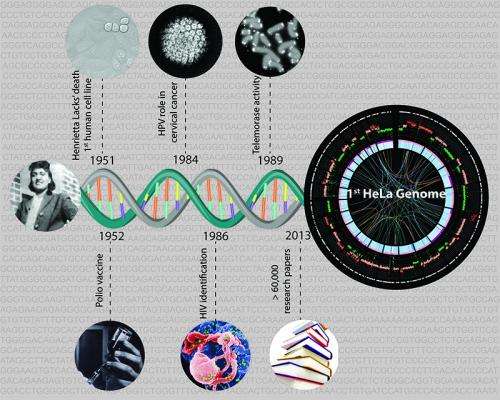Havoc in biology's most-used human cell line: Genome of HeLa cells sequenced for the first time

HeLa cells are the world's most commonly used human cell lines, and have served as a standard for understanding many fundamental biological processes. In a study published today in G3: Genes, Genomes and Genetics online, scientists at the European Molecular Biology Laboratory in Heidelberg, announce they have successfully sequenced the genome of a HeLa cell line. It provides a high-resolution genomic reference that reveals the striking differences between the HeLa genome and that of normal human cells. The study could improve the way HeLa cells are used to model human biology.
The scientists' analysis of the HeLa genome revealed widespread abnormalities in both the number and structure of chromosomes, as well as factors commonly associated with cancer cells like losing healthy copies of genes. In particular, the researchers found that countless regions of the chromosomes in each cell were arranged in the wrong order and had extra or fewer copies of genes. This is a telltale sign of chromosome shattering, a recently discovered phenomenon associated with 2-3% of all cancers. Knowledge of the genetic landscape of these cells can inform the design of future studies using HeLa cells, and strengthen the biological conclusions that can be made from them.
"The results provide the first detailed sequence of a HeLa genome," explain Jonathan Landry and Paul Pyl from EMBL, who carried out the research. "It demonstrates how genetically complex HeLa is compared to normal human tissue. Yet, possibly because of this complexity, no one had systematically sequenced the genome, until now."
"Our study underscores the importance of accounting for the abnormal characteristics of HeLa cells in experimental design and analysis, and has the potential to refine the use of HeLa cells as a model of human biology," adds Lars Steinmetz from EMBL, who led the project.
For decades HeLa cells have provided effective and easily usable biological models for researching human biology and disease. They are widely regarded as the 'industry standard' tool for studying human biology. Studies using them have led to two Nobel prizes and a host of advancements in many areas, including cancer, HIV/AIDS and the development of the polio vaccine. The HeLa genome had never been sequenced before, and modern molecular genetic studies using HeLa cells are typically designed and analysed using the Human Genome Project reference. This, however, misrepresents the sequence chaos that characterises HeLa cells, since they were derived from a cervical tumour and have since been adapting in laboratories for decades.
The study provides a high-resolution genetic picture of a key research tool for human biology. It highlights the extensive differences that cell lines can have from the human reference, indicating that such characterisation is important for all research involving cell lines and could improve the insights they deliver into human biology.
More information: Landry, J. et al. The genomic and transcriptomic landscape of a HeLa cell line, - Advanced online publication in G3: Genes, Genomes and Genetics on 11th March 2013. DOI: 10.1534/g3.113.005777
















